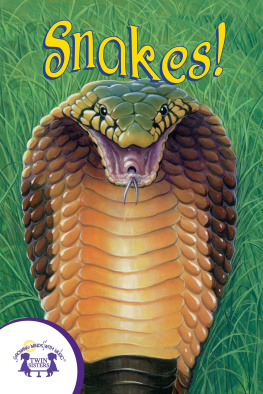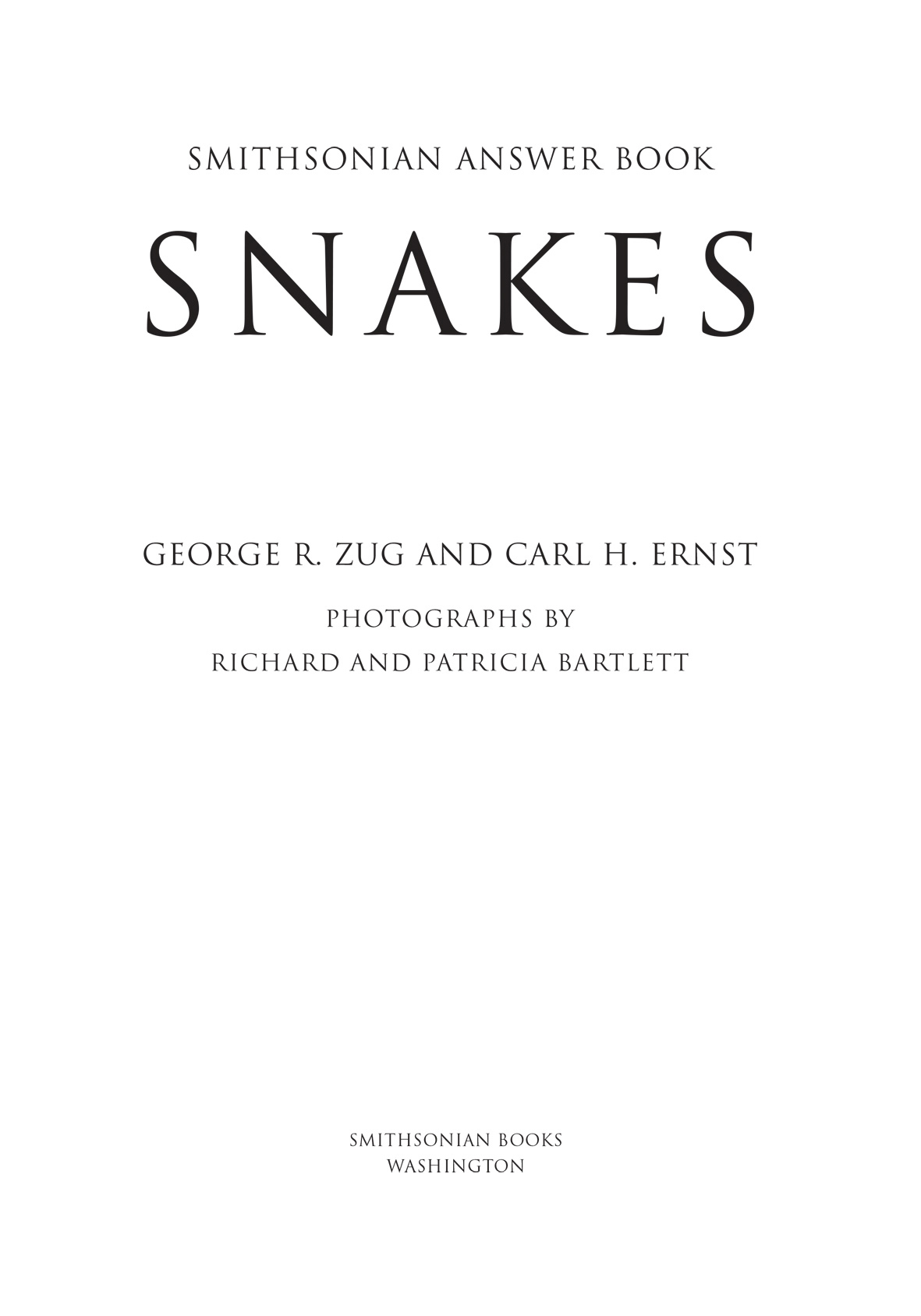2004 by the Smithsonian Institution
Photographs by Richard and Patricia Bartlett
All rights reserved
Copyeditor: Fran Aitkens
Production Editor: Robert A. Poarch
Designer: Janice Wheeler
Library of Congress Cataloging-in-Publication Data
Zug, George R., 1938
Snakes : Smithsonian answer book / George R. Zug and Carl H. Ernst.2nd ed.
p. cm.
Rev. ed. of: Snakes in question / Carl H. Ernst and George R. Zug; illustrations by Molly Dwyer
Griffin. c1996.
Includes bibliographical references (p.).
eBook ISBN: 978-1-58834-515-8
Trade Paperback ISBN: 978-1-58834-114-3
Hardcover ISBN: 978-1-58834-113-6
1. SnakesMiscellanea. I. Ernst, Carl H. II. Ernst, Carl H. Snakes in question. III. Title.
QL666.O6E48 2004
597.96dc22 2003059020
British Library Cataloguing-in-Publication Data are available.
For permission to reproduce illustrations appearing in this book, please correspond with the photographers or the owners of the works, as listed in the individual captions. Smithsonian Books does not retain reproduction rights for these illustrations individually or maintain a file of addresses for photo sources.
Frontispiece: Cape cobra ( Naja nivea )
This book may be purchased for education, business, or sales promotional use. For information please write: Special Markets Department, Smithsonian Books, P.O Box 37012, MRC 513, Washington, DC 20013.
www.SmithsonianBooks.com
v3.1
To biologists and naturalists, past and present,
who have gathered the facts about snakes,
and to our wives, Pat and Evelyn,
for years of support.
CONTENTS
.1.
SNAKE FACTS
.2.
FOLKTALES
.3.
GIANT SNAKES: BIG AND BIGGEST
.4.
SNAKEBITE
.5.
SNAKES AND US
Mexican speckled racer ( Drymobius margaritiferus )
PREFACE
Snakes fascinate, thrill, and even repel us. They fascinate us because they are limbless but can do many things we would not expect them to do. They thrill us because some are gigantic, others are venomous, and all represent the mystery of the unknown. But why do they repel us? The reason for our repulsion is unclear. Human beings may be innately wary of serpentlike creatures, but repulsion is probably a learned response. It probably arises from folktales and exaggeration, and perhaps from the association of the metaphorical serpent in the Garden of Eden with actual snakes. Childhood associations of snakes with danger and evil become part of a mental outlook, more subconscious than conscious, that can be changed only with effort and access to accurate information. Thus our first goal in writing this book is to present accurate information. We believe that understanding snakes makes them less frightening and threatening. And the more they are appreciated as normal members of natural communities, the less likely they are to be killed out of fear.
Snakes in Question sets out to answer the most frequently asked questions about snakes. Organized in question-and-answer format like its predecessor Sharks in Question , it also offers insight into the basic biology of snakes. Snake biology is full of strange and unexpected facts, few of which are widely known. Although the book is aimed at North American readers, its scope is worldwide. We assume that readers have heightened curiosity about snakes, perhaps stimulated by encounters with snakes in zoos or in the wild, or by television nature programs. Like such programs, this book also presents strange and spectacular facts, but we have tried to do so in the context of the basics of snake biology and diversity. Snake Facts presents those basics. In Folktales we examine some common misunderstandings about snakes and attempt to trace how such misunderstandings arose from incomplete observation and how observational errors are compounded by misinterpretation. Giant Snakes: Big and Biggest focuses on awesomely gigantic snakes, and Snakebite looks at the danger, often overstated but nonetheless real, of a snakebite. In Snakes and Us we examine the relationship between snakes and humans. Because we expect most readers to pursue questions that interest them rather than reading sequentially, some information appears in several sections.
Much has been written about snakes. We have compiled two types of bibliographies to guide the readers who want to know more. The general bibliography is a list of popular and broader-scope books about snakes and their biology. The subject bibliography gives lists of recommended further readings on each of the major topics covered in this book. It is organized like the text; publications are listed according to the particular question about snakes that they address.
ACKNOWLEDGMENTS
FIRST EDITION
Peter Cannell first suggested that we write about snakes for the second Smithsonian Answer Book. The question-answerers (Ron Crombie, Steve Gotte, Bob Reynolds, and Addison Wynn, all with the National Museum of Natural History, Division of Amphibians and Reptiles) gave us encouragement and ideas, and then reviewed the entire first draft of the manuscript. Joy Gold, Duane Hope, and Van Wallach also read and commented on the entire manuscript. Other colleagues, including Kraig Adler, Tom Anton, David L. Auth, William S. Brown, Peter Cannell, David Cundall, Herndon G. Dowling, Carl Gans, David L. Hardy, Robert W. Henderson, J. Alan Holman, Fran Irish, Karl V. Kardong, Ernest A. Liner, Sherman A. Minton, Alan Resetar, Jose P. Rosado, Richard A. Seigel, Joseph B. Slowinski, Peter D. Strimple, and Bruce A. Young, have read various sections, ferreted out errors, and offered helpful suggestions. Our wives, Evelyn and Pat, encouraged us throughout and occasionally lent a hand to type portions of the text. We appreciate the generous assistance of all, and thank them for making this a better book. We alone remain responsible for any remaining errors.
SECOND EDITION
With the continual appearance of snake books, often with more glitch than accuracy, Vince Burke recognized the need to update Snakes in Question in a more eye-catching format through the addition of color photographs. We were delighted with his suggestion because it gave us an opportunity to do some fine-scale tweaking of the text and to present some of the new ideas concerning snake origins and classification. We remain in debt to the reviewers of and contributors to the first edition and to Ann Goodsell, our former editor, who created readable prose without losing scientific accuracy. Our current editor, Fran Aitkens, also has polished our prose; Nicole Sloane of Smithsonian Books has coordinated image selection and other must-do aspects for publication of this edition. Thanks to both! We also wish to thank Kerry Hanskecht for providing snake diving data and Jason Head for the latest information on fossil snakes and assistance with color preparation of the line art.
Most of the photographs are by Dick and Pat Bartlett. When they were unable to provide the desired images, other colleagues graciously helped. Their images are identified by their names in parentheses at the end of the image legends.












